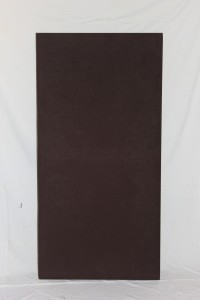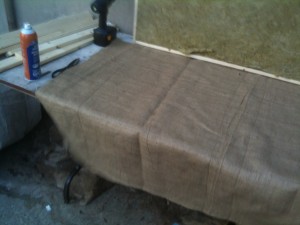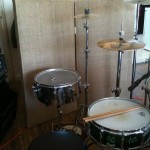 (Update: Click here for the full diy sound panel tutorial, or visit InityAcoustics.com for professionally made panels)
(Update: Click here for the full diy sound panel tutorial, or visit InityAcoustics.com for professionally made panels)
I know, we’re actually at week 19 of 2012, and it’s been about a month since I’ve posted. My aim with WeeklyCreations.com has been to keep my posts to a weekly schedule, but I’ve been (happily) tied up with the new sound panels business, amongst a couple other projects with the studio. So although we’re at week 19 of 2012, I’ll jump back and get Week 15 done first and make my way back on track.
I’ve recently had a few people voice the assumption that I won’t be posting the sound panel construction tutorial, seen as I now have a business selling them. But indeed I will be posting it! I think we have a tendency to feel threatened by competition. And I think the two main concerns a person would have with this particular situation are:
- What if my potential customers make my product themselves instead of buying it from me?
- What if someone else starts manufacturing my product as well, causing my business to go under?
I’ll admit, these are thoughts that ran through my head. They’re thoughts that run through my head with every business endeavor I’ve partaken in. But in reality, they’re just not relevant. They’re fears born of a scarcity mindset and a lack of real understanding for what makes a business work.
Why I’m Not Concerned
Potential Customers Lost To DIY!?! Oh Noooo!!
I’m not worried about losing customers for numerous reasons. Firstly, a lot can be said for the time and money saved through mass production. Having made enough of these panels, not only do I know the ins and outs, but it’s also been worth my while to bust my ass these last couple months and invest the time and money into buying the right tools and making quality jigs that serve to speed up and perfect the process.
A jig is like a template, or sort of cookie cutter for a particular stage of the manufacturing process. For example, the simplest one I have is for cutting my lumber to the right lengths. I attached blocks of scrap wood to my table top at pre-measured distances from my saw blade, allowing me to just throw framing lumber under the saw and push it up against the block for a perfectly sized cut every time without ever having to measure ever again. I use similar time savers throughout the whole manufacturing process. Some simple, some complex. But all worth it – if making more than just a few of a particular product.
Anyone can do this, and I think you should think up ways to do it with whatever kind of work you do! In fact, I think a future Weekly Creations post will be for a website where people can share jigs and templates ideas for any and every type of work, and even for very specific jobs. I think it’ll be great to help fellow DIYers, managers and entrepreneurs involved with companies of all sizes to improve their manufacturing process or productivity, making for a more efficient, less competitive, and more harmonious world.
Anyway, as good as jigs are, in some cases this approach would be wasteful and just not feasible. If creating a product for just oneself, creating jigs can take far more time than just creating the product itself directly. I would never have created these jigs or bought the better tools for the first run of panels I made for personal use – or even the first several orders. The jigs and tools cost much, much more than the materials for a single standard order, and have taken way more time to think up, design, create and develop than a dozen orders. But the end result of having mass production tools and jigs means a sturdier, well made product that can be made fast enough to keep the product price at a point well worth the time a customer can save by not having to make the product him/herself.
These developments to the process to facilitate high volume means what would take an individual without the jigs and custom tools an hour to do, I can do in half the time or less, and less labor time means less labor cost. Since for most of us time = money, that means buying something from an effective mass producer means more value for less time/money than it would take to do it yourself – depending on what your time is worth to you.
That said, if you have some of the basic tools and more free time than money, and you want to save on the cost of labor, I totally think you should build yourself any products you desire! I certainly do exactly that. The DIY mentality is good for individuals and society alike. With the panels business I can earn money from serving people who haven’t the time or interest for taking on such a project. I don’t need to earn it from people who need the cash (or could make better use of it elsewhere) and whom want to develop their DIY muscle! 🙂
Competing Businesses?!? Aaaaagghhh!!
And I’m definitely not worried about competing businesses. One thing I’ve learned in business is that ideas aren’t worth money. Execution of ideas is what’s worth money. The ideas themselves are merely multipliers of the value of the execution. Derek Sivers (creator of CDBaby.com) wrote about this on his blog. This is Derek’s basic explanation.
AWFUL IDEA = -1
WEAK IDEA = 1
SO-SO IDEA = 5
GOOD IDEA = 10
GREAT IDEA = 15
BRILLIANT IDEA = 20
NO EXECUTION = $1
WEAK EXECUTION = $1000
SO-SO EXECUTION = $10,000
GOOD EXECUTION = $100,000
GREAT EXECUTION = $1,000,000
BRILLIANT EXECUTION = $10,000,000
So for this idea to be worth anything, it has to be combined with quality execution. The business connections I’ve made and relationships with customers I’ve built are more important than any particular idea or knowledge of how to build a product. Same goes for relevant experience, business training, planning, marketing, product development, manufacturing process development, budgeting, etc. These things are all far more important to the success of a business than just a good idea or product.
Ideas aren’t the hard part. They’re a dime a dozen. It’s execution of ideas – the hard work, smart work, and persistent work – that’s the hard part. Though actually, I’m starting to think it’s not that hard. It’s just something to get the hang of.
Bottom line is, just because you know how to make a pizza, doesn’t mean your local pizza place should feel threatened. They may even sell you prepared toppings for your home cooking if you ask nicely. 😉
So, in the next Weekly Creations post I will show you the basic process of making these panels for yourself.





